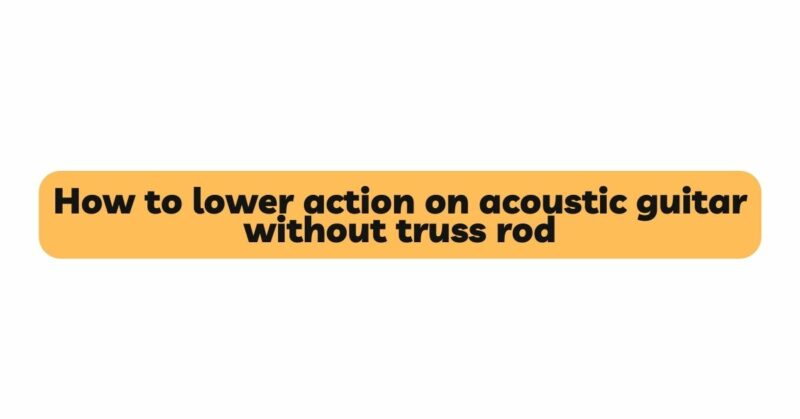The acoustic guitar, a versatile instrument with a rich history, has captivated musicians and audiences worldwide with its melodic allure. Achieving optimal playability is a guitarist’s endeavor, and string action significantly influences this goal. Lowering the action – the distance between the strings and the fretboard – enhances the guitar’s responsiveness and ease of playing. While truss rod adjustments are commonly used to alter action, there are alternative methods that allow you to lower the action without manipulating the truss rod. In this comprehensive article, we explore these alternative approaches, detailing step-by-step methods to achieve the desired action and elevate your acoustic guitar playing experience.
Understanding Acoustic Guitar Action: String action plays a pivotal role in the playability, tone, and overall feel of an acoustic guitar. Proper action facilitates effortless fretting, clean chord transitions, and comfortable execution of techniques. Lowering the action can make your guitar more forgiving and enjoyable to play, inspiring creativity and musical expression.
Alternative Methods for Lowering Acoustic Guitar Action: When aiming to lower the action on your acoustic guitar without adjusting the truss rod, consider these alternative methods:
- Saddle Adjustment: The saddle, located in the bridge, directly affects the action. By carefully modifying the saddle height, you can lower the action. Here’s how:
- Measure Initial Action: Begin by measuring the current action at the 12th fret using a feeler gauge. Note the measurement as a reference.
- Loosen Strings: To avoid damage and facilitate saddle removal, loosen the strings to reduce tension.
- Remove Saddle: Gently remove the saddle from the bridge, using caution to avoid any damage.
- Sand Down Saddle: Carefully sand down the bottom of the saddle using fine-grit sandpaper. Gradually remove small increments of material, keeping the saddle level.
- Reassemble and Test: Once you achieve the desired action height, reinsert the saddle, tighten the strings, and tune the guitar. Test the playability and adjust further if necessary.
- Nut Adjustment: The nut, located at the top of the neck, also influences string height. Modifying the nut slots can contribute to lowering the action:
- Measure Initial Action: Measure the current action at the 1st fret using a feeler gauge for reference.
- Loosen Strings: Loosen the strings to relieve tension before working on the nut.
- File Nut Slots: Gently file the nut slots using nut files or sandpaper. Gradually widen the slots to lower the action.
- Check and Test: Ensure that the strings fit comfortably in the modified slots. Re-tune the guitar, and test the action’s playability.
- Bridge Shaving: For more advanced adjustments, you can shave the bridge’s underside to lower the action:
- Consult a Professional: This method requires precision and expertise. It’s advisable to consult a skilled guitar technician who can accurately assess the bridge and execute the shaving process.
- Professional Luthier Services: Enlisting the services of a professional luthier or guitar technician ensures accurate action adjustment. A luthier possesses the expertise and tools necessary to achieve precise action modifications.
Considerations and Precautions: Lowering the action without adjusting the truss rod requires careful attention and precautions:
- Incremental Changes: Make small adjustments to the saddle and nut heights to avoid over-correcting and causing issues.
- Monitor Intonation: As you modify action, keep an eye on the guitar’s intonation. Drastic action changes can impact intonation and require further adjustments.
- Avoid Over-Filing: When filing nut slots or sanding the saddle, proceed cautiously to prevent permanent damage. It’s easier to remove material than to reverse excessive modification.
- Professional Consultation: If you’re uncertain about making adjustments yourself, seek the guidance of a professional luthier or guitar technician. Their expertise ensures that your guitar’s setup is optimal.
Conclusion: Lowering the action on an acoustic guitar without adjusting the truss rod opens a pathway to enhancing your playing experience. By focusing on saddle, nut, and bridge modifications, you can achieve the desired string action and unlock your guitar’s full potential. Remember that patience, precision, and attention to detail are paramount in achieving successful adjustments. Whether you’re a seasoned player seeking personalized playability or a beginner discovering the joys of the instrument, the process of modifying action is a testament to your commitment to musical excellence. As you embark on this journey, embrace the harmony between your artistic aspirations and the physical nuances of your guitar, fostering a deeper connection with your instrument and the melodies you create.


